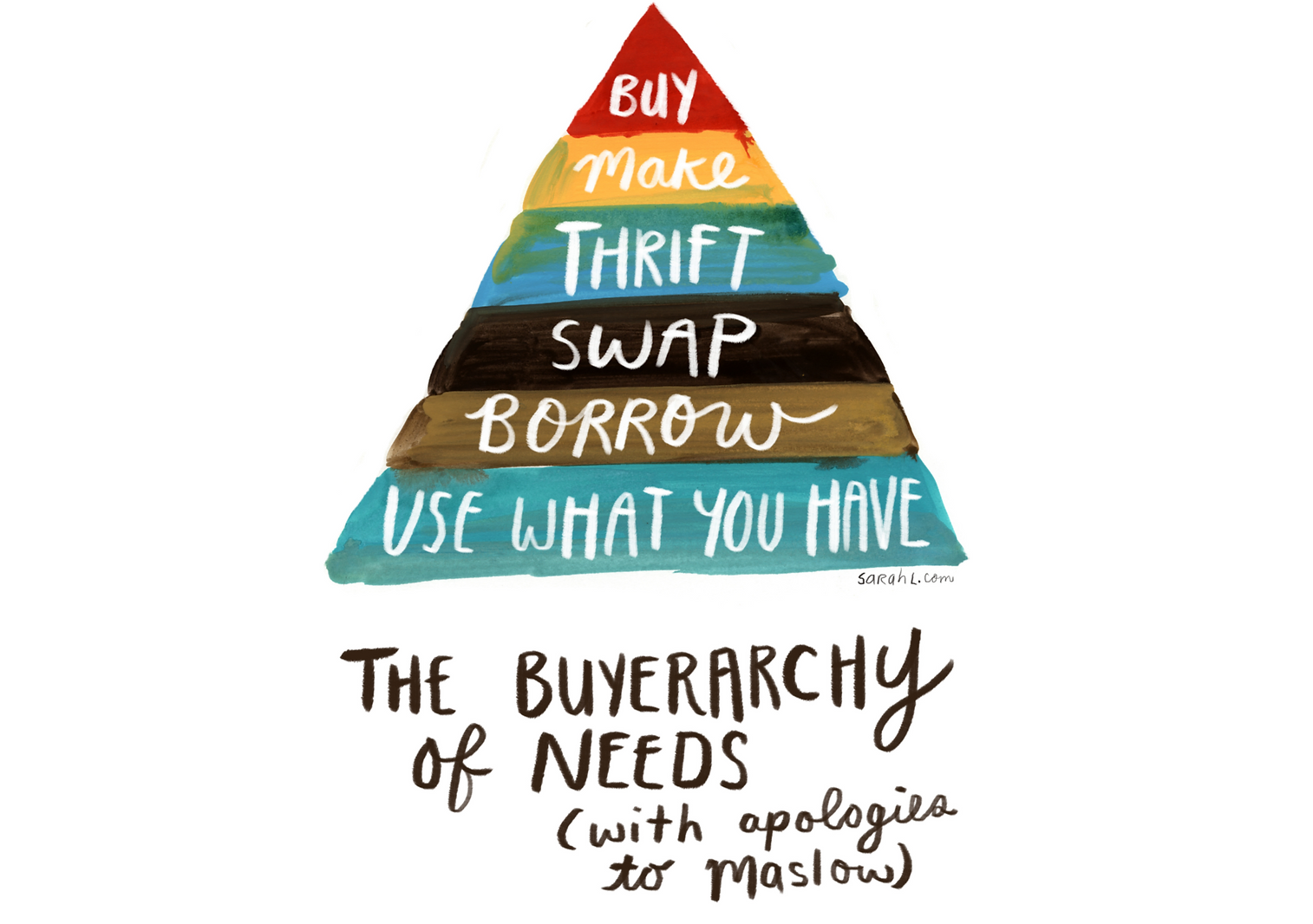Welcome to The A to Z of going eco-friendly! I’ve set myself the challenge of coming up with a list of sustainability-related words that might help those of us getting started on the journey.
*This article contains affiliate links*
We all know that, as a society, we love to buy stuff. Consumerism is ingrained into our way of life – in fact, it’s pretty much a mandatory part of our lives that keeps the economy going. Most of us don’t even think about it anymore.
It’s also well known that we buy too much stuff: stuff that uses resources to make and takes up even more space once it’s past it’s usefulness.
The Buyerarchy of Needs
Designed by Sarah Lazarovic, the Buyarchy of Needs is a great way of looking at our need to buy anything. Starting at the bottom, whenever you have an idea to buy something new, look at whether you can do any of the other things first.

The idea is not to stop buying or become a minimalist – unless that’s your goal of course. You still want to enjoy your life and, more importantly, not feel guilty about having to buy something. The point of the buyerarchy is to look at the alternatives first. If nothing else, it helps you to think about a purchase before going on impulse.
Use what you have
Right at the bottom of the Buyerarchy, the first step is to use what you have. In other words, do you really need to buy anything at all? Can you use what you have? Fix something that is broken?
Our mobile phones and tablets are a great example of this and I must admit, I’ve been a sucker for many years. This year, however, I’ve decided to save my money & the planet a little by keeping my current mobile for a little while longer.
Borrow
If there’s something you really need, could you borrow or rent it? If you’re only going to need something for a single project or event, join the sharing economy! It’s really possible to borrow anything from power tools to clothes if you know where to look. Many places around the country now have a sharing library or a place to rent items for a fee. In Salisbury, we have a Library of Things called Share Salisbury. You can rent anything from a karaoke machine to a hedge trimmer for a small fee or sign up for monthly membership.
Don’t forget the good old fashioned library if you are a reader.
Swap
‘Swishing’ or swapping clothes is a great way to shake up your wardrobe. Get together with friends and trade clothes that you no longer need. I’ve heard of local events happening too where people take along items they no longer want to trade with others.
As well as clothes, think about swapping things like books (a great idea for a book club), children’s toys or even skills.
Thrift – or buying second-hand
Charity shops are a great place to start when buying second hand. Some charities have furniture shops and book shops as well as selling clothes. The choice of stuff is getting better too, as long as you have the patience to trawl through it of course.
There are other places to shop second hand too. Many towns have vintage emporiums (Salisbury actually has three) where you can buy all sorts of items including clothing. A lot of these places are shops within shops – local businesses that rent a space inside the emporium and sell their wares. Vintage lovers will love searching through places like these.
Preloved shops are also popping up: places you can buy and sell items. This is a popular outlet for clothing and offers a more select way of shopping for second hand clothes than a charity shop.
Other sources of thrifty purchases are E-Bay, FreeCycle and Preloved. Also, check out you local car boot sale or vintage fair for some bargains.
Make / DIY
If you have a sewing machine or a set of tools & you are fairly handy with them, think about doing it yourself. If you have these things but aren’t that handy with them, why not learn how? YouTube is a great source of how-tos or, if you’re really into it, try an evening class. You never know, you might discover your next hobby.
This autumn, I’ve seen a lot of fabric and knitted pumpkins in the shops. It seems to be a bit of a trend. I had a lot of spare wool and I’m not bad at knitting so I decided to make some. I found a free pattern online & rustled up a couple in a few days.
Buy (new)
Right at the top, and the ultimate last resort, is to buy new. I started this post by saying that, the point of the buyerarchy is not to stop buying new – just don’t do it all the time. If you need to buy new, think about what you’re buying and ask a few questions before you do:
- Where is it from? Think about who made it and what it’s made of. Is it sustainable, mass produced or overly cheap?
- How long will it last? Will you need to replace it in a few months time? Consider spending a little more on something that will last and making an investment.
- How will you need to dispose of it? Think about where it will go once you’re done with it. Could you donate it or put it to good use? Would it be easy to fix or recycle?
Ultimately, buy the best you can afford if at all possible.
The next time you are considering making a purchase, consider the Buyerarchy of Needs. Ask yourself the questions above and allow yourself to take a step back before you leap into impulse-buying mode.
“Buy less. Choose well. Make it last.” — Vivienne Westwood

